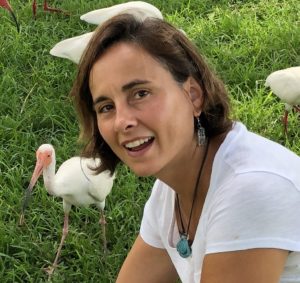Transcribed by Jorge Rojas
I am a professor at the University of Georgia with a joint appointment at the Warnell School of Forestry and Natural Resources and the College of Veterinary Medicine, and my main focus is to teach and conduct research at the intersection of human, animal and ecosystem health.
I am also passionate about advancing the study of wildlife diseases, not just because wildlife may be reservoirs of human diseases, but because these diseases affect wildlife populations, sometimes with detrimental effects. I like to study wildlife in anthropogenic habitats, where human-wildlife interactions have increased in recent decades and where the dynamics of pathogens have shifted, sometimes resulting in increased transmission or disease.
One of the best examples on how I investigate this is through the white-ibis project. Back in 2014, through a National Science Foundation (NSF) grant I organized a dedicated team to understand how urbanization affects the health and ecology of the white ibis. With some of my students, we investigated white-ibis diet composition, stress, movement and resource selection, and we have determined that an anthropogenic diet affects the health of these birds.
More recently, through another NSF grant we did an experiment with one of my students to determine the susceptibility from North American raccoons and striped skunks to SARS-CoV-2. We inoculated the virus under controlled conditions, and found that although skunks are susceptible and shed, neither of them likely play an important role in the epidemiology of SARS-CoV-2 because they do not shed enough virus, making them unlikely for SARS-CoV-2 to become established in their populations and for virus to spillback into humans.
In the 1990’s I was fortunate to work on free-living Baird’s tapirs in Costa Rica. Through that research, I became deeply attached to this country for its culture, nature, wildlife, and its successful management of protected areas. Thus, I was motivated to return in 2004 to conduct my PhD in the Monteverde highlands where I investigated the avian community composition and pathogen dynamics at a human-wildlife interface in a heterogenous matrix dominated by small-scale coffee farms, and cloud forest patches. Through both of these experiences, I learned a lot from Costa Ricans, their enthusiasm to protect wildlife, and the importance of local communities for conservation.
This was one of the main reasons why I initiated the study abroad – Conservation Medicine & Biology Course, every two years in Costa Rica. Conservation Medicine is a relatively new discipline that tackles the intersection between human, animal, and ecosystem health. This course mixes the principles of conservation medicine and biology, and examines the primary conservation problems in our world (with a focus on tropical countries and exploring different ecosystems across Costa Rica) in the context of health. By far my favorite courses involve those that allow me to take students into the field, therefore, I devote most of the class to being outdoors observing and studying biodiversity.
In 2019, I followed my passion for Costa Rican wildlife and especially for tapirs. Once again, I came back to investigate this endangered mammal that is now leaving protected areas and wandering in a fragmented landscape in Northwestern, Costa Rica. Here, tapirs have shifted their behavior, where they are feeding during the day and raiding crops. In this Biological Corridor, human-tapir conflicts are common, but through some local residents’ initiative and leadership the community have been promoting tapir conservation regionally. With my Costa Rican student, we started to investigate tapirs movement and habitat preferences in this landscape by capturing and outfitting tapirs with GPS radiocollars. Also, we are conducting a field experiment to test different repellents to decrease farmer-tapir conflicts.
I am a strong believer that in order to tackle complex ecological problems, we need to build interdisciplinary teams. A couple of years ago, through a Fulbright Fellowship I spent 6 months collaborating with ecologist Dr. Jose Aguirre at the Universidad Complutense in Madrid, Spain to understand the impact of using anthropogenic habitats on the ecology and health of the white stork. Dr. Aguirre’s Lab has been conducting a long-term population monitoring of white storks. Similarly, as the white ibis, we used white storks as a model species to analyze their health in urban settings, where these birds are feeding from human waste.

